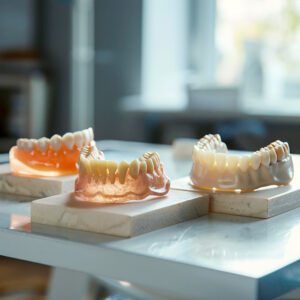What are Dental Implants?
Dental implants serve as artificial tooth roots, designed to replace missing teeth with a secure and durable solution. These implants are typically crafted from biocompatible titanium, which integrates seamlessly with the jawbone through a process known as osseointegration. This ensures that the implant becomes a stable foundation for various types of dental prosthetics, including crowns, bridges, and dentures.
There are primarily two types of dental implants: endosteal and subperiosteal. Endosteal implants are the most commonly used and are inserted directly into the jawbone. These implants usually take the form of small screws, plates, or cylinders that provide a robust support system for replacement teeth. The healing time associated with endosteal implants may vary, but typically, patients may experience full integration within a few months.
On the other hand, subperiosteal implants are placed under the gum but above the jawbone. This type of implant is used when there is not enough healthy natural bone to secure an endosteal implant. A custom-shaped metal framework is situated beneath the gum tissue, which then allows for the attachment of replacement teeth. While subperiosteal implants may offer a solution for patients with insufficient bone density, they are less commonly utilized due to advancements in bone grafting techniques and implant technology.
Overall, dental implants function as a secure and long-lasting solution for tooth replacement, providing numerous benefits, including improved aesthetics, restored chewing functionality, and enhanced oral health. The choice of implant type will depend on the specific needs and dental condition of each patient, with an emphasis on providing a reliable foundation for functional and cosmetic restorations.
Why Choose Dental Implants?
Dental implants stand out as a highly effective solution for tooth replacement, offering a variety of benefits that cater to both aesthetics and functionality. One of the primary advantages of dental implants is their ability to mimic the natural look and feel of existing teeth. This contributes to improved appearance, as patients regain their confidence and smile without the self-consciousness often associated with traditional dentures or bridges.
In addition to appearance, dental implants provide significant comfort. Unlike dentures, which can shift and cause discomfort, implants are securely anchored into the jawbone, eliminating concerns related to slippage. This stability allows individuals to enjoy their favorite foods without restriction, enhancing their overall quality of life. Furthermore, improved speech is another vital benefit; many patients notice a dramatic reduction in issues such as mumbling or slurring that have plagued them with ill-fitting dentures.
Dental implants also promote better oral health compared to other options. When a tooth is lost, the surrounding bone tends to deteriorate over time. Traditional bridges require the alteration of adjacent teeth, potentially compromising their integrity. Dental implants, on the other hand, stimulate bone growth by acting as a replacement tooth root, thereby helping to prevent bone loss and preserving the natural structure of the face. This contributes to maintaining facial aesthetics, which can diminish as teeth are lost.
Durability is another critical factor that sets dental implants apart. With proper care, implants can last a lifetime, proving to be a more economical investment over time when compared to bridges and dentures, which may require replacement. As a result, for those seeking a reliable and effective tooth replacement option, dental implants provide numerous advantages that significantly improve both oral health and overall well-being.
The Dental Implant Process: Step-by-Step
The journey to receiving dental implants begins with an initial consultation with a qualified dental professional. During this visit, the dentist will evaluate the patient’s oral health, discuss medical history, and determine whether dental implants are a suitable option. This assessment may involve taking X-rays or 3D scans to assess bone density and structure, which is critical for the successful placement of an implant.
Once the dentist has gathered all necessary information, they will develop a personalized treatment plan. This plan outlines the number of implants required, the type of implant to be used, and the overall timeline for the procedure. Patients may also be informed about the potential need for preparatory treatments, such as bone grafting, if there is insufficient bone to support the implant.
The next phase involves the surgical procedure. Typically performed under local anesthesia, the dentist or oral surgeon will make an incision in the gum tissue to expose the bone. A small hole is then drilled into the bone to create space for the implant, which is a titanium post that serves as the tooth root. After placing the implant, the gum is stitched closed. This process requires a recovery period known as osseointegration, where the implant fuses with the jawbone, taking anywhere from three to six months.
Following the healing period, patients will return for a follow-up appointment where the dentist will assess the integration of the implant. If the healing is successful, an abutment is placed on the implant, which will later hold the crown. The final step is the placement of the custom-made dental crown, completing the restoration. Post-operative care is essential for optimal recovery. Patients should follow their dentist’s recommendations for maintaining oral hygiene and attending routine check-ups to monitor the implant’s success, ensuring longevity and functionality.
Cost of Dental Implants in the USA
Dental implants have emerged as a viable solution for individuals seeking to restore their smile and oral function. However, the financial implications of this procedure can vary significantly based on several factors. One crucial aspect influencing the overall cost of dental implants in the USA is the geographical location. Prices tend to differ from one region to another, with metropolitan areas generally having higher costs due to increased overhead for dental practices.
Another important consideration is the dentist’s level of expertise and specialization. Highly experienced implantologists often charge more for their services, reflecting their advanced training and successful outcomes. In addition, the complexity of the case can affect pricing. For instance, patients requiring additional procedures such as bone grafting or sinus lifts may incur higher expenses.
The number of implants needed also plays a significant role in determining total costs. While a single implant will obviously cost less than multiple implants, it is important to consider the long-term investment in oral health that implants represent. Generally, the average price range for a single dental implant in the USA can be anywhere from $3,000 to $4,500, including consultation, surgery, and follow-up visits. Regional differences can lead to costs exceeding this range, particularly in urban centers.
Insurance coverage for dental implants is another factor to take into account. While many insurance plans may not cover the entire cost, some may offer partial reimbursement. Therefore, it is essential to consult with one’s insurance provider to understand the specifics of coverage. There are also various financing options available, such as payment plans or healthcare credit cards, that can make the procedure more manageable financially. Understanding these elements will help individuals make informed decisions regarding their dental health and budgeting for dental implants.
Choosing the Right Dentist for Implants
Selecting a qualified dentist for your dental implant procedure is crucial for ensuring a successful outcome. One of the primary factors to consider is the dentist’s credentials. It is advisable to seek out a professional who is board-certified in implant dentistry or oral surgery. Board certification indicates that the dentist has undergone rigorous training and has met the high standards set by relevant professional organizations. Furthermore, experience plays a significant role; a dentist with a solid track record in performing implant procedures is often better equipped to handle potential complications that may arise during the surgery.
Researching dentists who specialize in implants can be facilitated through various platforms. Start by visiting official dental association websites or local dental society listings that provide information on qualified professionals in your area. Online reviews can also provide insight into patient experiences and outcomes. However, it is essential to approach such reviews critically, as individual experiences may vary significantly.
When you narrow down your choices, don’t hesitate to arrange consultations with potential dentists. During these meetings, it is vital to ask the right questions. Inquire about the dentist’s specific experience with dental implants, including the number of procedures performed and any ongoing education or training in the field. Discuss their approach to follow-up care and how complications, should they arise, are managed. This open dialogue not only gives you a better understanding of the dentist’s expertise but also allows you to assess their communication style and comfort level. Remember, finding the right dentist for your dental implants can significantly impact the overall success of your treatment.
Understanding Risks and Complications
Dental implants are a popular solution for replacing missing teeth, offering improved aesthetic appeal and functionality. However, as with any surgical procedure, there are potential risks and complications associated with dental implants that patients should be aware of. Understanding these issues is crucial for anyone considering this treatment option, as it informs their decisions and helps them manage post-operative care.
One of the primary risks is infection at the implant site. This can occur due to bacteria entering the surgical area, leading to potential complications such as peri-implantitis, which is akin to gum disease around natural teeth. Proper oral hygiene, routine follow-ups, and adherence to the dentist’s post-operative care instructions are essential to reduce this risk. Symptoms of infection may include swelling, pain, or pus discharge, signaling the need for immediate attention from a dental professional.
Another complication is nerve damage, which can occur if the implant is placed too close to the nerves in the jaw. This may result in discomfort, numbness, or tingling in the surrounding areas. Careful planning and imaging techniques, such as 3D scans, are crucial in minimizing the likelihood of such occurrences. Patients should be vigilant about any unusual sensations following surgery and report them to their dentist.
Furthermore, implant failure is a possibility, which can stem from inadequate bone density or improper placement. Factors such as smoking, uncontrolled diabetes, or insufficient oral hygiene can compromise the success of dental implants. It is vital for prospective patients to have a thorough consultation with their dentist, discussing their health history and lifestyle choices. This will aid in identifying potential issues before the procedure, allowing for better planning and customized aftercare strategies to enhance the likelihood of successful outcomes.
Aftercare and Maintenance for Dental Implants
Dental implants require careful aftercare and maintenance to ensure their longevity and effectiveness. Just like natural teeth, implants benefit from a solid oral hygiene regimen. Proper brushing, flossing, and rinsing are essential to keep both the implants and surrounding gums healthy. Patients should brush their teeth at least twice daily using a soft-bristled toothbrush and a non-abrasive toothpaste. Additionally, supplemental cleaning methods such as interdental brushes or water flossers can aid in removing food particles and plaque from hard-to-reach areas around the implants.
It is equally important for individuals with dental implants to maintain regular dental check-ups. Dental professionals will monitor the condition of the implants, assess the health of surrounding tissues, and perform professional cleanings as necessary. These visits typically occur every six months but may be more frequent based on individual needs. Early detection of any issues can help prevent complications that could lead to implant failure.
Dietary choices also play a significant role in the maintenance of dental implants. A well-balanced diet rich in vitamins and minerals promotes healing and supports overall oral health. It is advisable to limit the intake of hard, sticky, or sugary foods, which may exert excessive force on implants or contribute to plaque buildup. Instead, focus on consuming soft foods, whole grains, lean proteins, fruits, and vegetables for optimal health.
Lifestyle factors should also be considered to ensure a successful outcome with dental implants. Smoking and excessive alcohol consumption can adversely affect oral health, potentially compromising the stability of the implants. Therefore, patients are encouraged to refrain from these habits and adopt a healthier lifestyle as a part of their aftercare plan. By diligently following these aftercare practices, individuals can enhance the durability and functionality of their dental implants.
Success Rates and Longevity of Dental Implants
Dental implants have gained prominence as a reliable solution for missing teeth, with impressive success rates reported across various clinical studies. Statistically, the success rate of dental implants typically ranges from 90% to 98% after a period of five years. However, this success is influenced by several factors, including the patient’s overall health, oral hygiene practices, and adherence to aftercare recommendations. Factors such as smoking, diabetes, and periodontal disease can adversely affect the integration of the dental implant with the jawbone, potentially lowering success rates.
Patients who maintain good oral hygiene and visit their dentist regularly demonstrate considerably higher success rates. Following the procedure, the aftercare regimen plays a critical role. Practicing effective brushing and flossing techniques, avoiding hard foods, and attending routine dental checkups contribute to the longevity and functionality of the implants. Those who commit to a rigorous aftercare program often report optimal outcomes for both health and aesthetics.
Regarding longevity, research indicates that dental implants can last anywhere from 10 to 30 years or more, depending on various factors. Studies suggest that with proper care and regular dental visits, many individuals find their implants serve them effectively for over two decades. Cost-wise, this demonstrates significant long-term value, as the initial investment in dental implants, when well cared for, often translates into years of reliable function and improved quality of life.
Ultimately, when considering a dental implant, it is critical to discuss individual factors with a dental professional to ensure the highest likelihood of success and longevity. Investing time and effort into good oral health practices can lead to lasting satisfaction and confidence in one’s smile.
Innovations in Dental Implant Technology
Advancements in dental implant technology have significantly transformed the field of restorative dentistry. One of the most noteworthy innovations is the incorporation of 3D imaging, which enhances the accuracy and precision of implant placement. This technology allows dental professionals to create a comprehensive three-dimensional model of a patient’s oral structure, facilitating a better understanding of the anatomy involved. Through detailed visualizations, clinicians can plan the optimal placement of implants, thereby minimizing the risks associated with surgery and improving overall outcomes.
Another groundbreaking development is guided implant surgery, which utilizes computer-assisted technology to assist in the surgical process. This technique involves the use of a surgical guide that directs the dental drills in real-time during the procedure, ensuring that the implants are placed in their ideal positions. As a result, the likelihood of complications decreases, and the surgical experience becomes more streamlined for both the practitioner and the patient. Such innovations reduce recovery times, allowing patients to experience quicker healing and a return to normal activities.
Looking ahead, future trends in dental implant technology are expected to focus on biomaterials and surface modifications that promote better integration of the implant with the bone tissue. Researchers are exploring the use of bioactive coatings and regenerative techniques that enhance osseointegration. Furthermore, advances in digital dentistry, including the use of artificial intelligence, may offer even more personalized treatment options, making dental implants more accessible and effective for a wider range of patients.
In conclusion, the ongoing innovations in dental implant technology signify a positive shift towards improved accuracy, reduced recovery times, and enhanced patient experiences. As we continue to witness these advancements, patients can expect more effective and tailored dental implant solutions in the near future.













